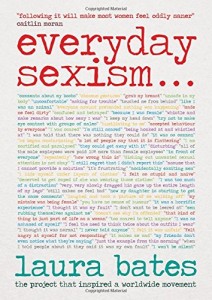lip lit: everyday sexism
Trigger warning: this review contains discussion of domestic violence, rape, sexual assault, sexual abuse and sexual harassment.
When Laura Bates started the Everyday Sexism Project back in April 2012, she did so with a simple goal in mind: to give women a place where they could share their stories.
Initiated in response to Bates’ experiences with street harassment, the Everyday Sexism Project was, from the very beginning, indiscriminate about the severity of the stories it shared. As Bates puts it, ‘I started a very simple website where women could upload their stories – from the niggling and normalised to the outrageously offensive – and those who hadn’t experienced the problem first-hand could read them and, I hoped, begin to realise what was really happening [to women] on a daily basis.’
The Project was, in its own way, something of a revolution, heralding the arrival of a new wave of feminism; or at least personifying the much-criticised ‘fourth-wave’ of feminism. The invention of the internet has precipitated a shift from the third to the fourth wave, having created a ‘culture in which in which sexism or misogyny can be easily ‘called out’ and challenged,’ as academic Ealasaid Munro put it. Critics would call it ‘clicktivism‘ or argue that fourth-wave feminism’s focus on popular culture is a sign that it lacks the capacity to be truly intersectional.
The Everyday Sexism Project perfectly embodied this kind of internet feminist activism. Groups like the Destroy the Joint, Tumblr blog Microaggressions or the popularity of the #YesAllWomen hashtag, all indicate that the Everyday Sexism Project is not a singular occurrence but part of a broader movement.
There is a lot of inherent value in the Everyday Sexism Project as it was in its original, web-based, Twitter-hashtag format. It achieved Bates’ original aims: it was readily embraced by women from all over the world, who wrote in by the thousands to testify about their experiences with street harassment, casual sexism slipped into workplace conversations, the daily onslaught of body-shaming media; but also with their stories of domestic violence and rape.
‘In the early days,’ Bates writes, ‘I wondered why people were coming to us – why they weren’t sharing and being supported elsewhere. And then I started to realise that there wasn’t anywhere else.’
Bates’ argument is interesting, and the service – the solace, the solidarity – provided by the Everyday Sexism Project to women around the world is of an incalculable worth. It is debatable whether or not Bates’ subsequent book, everyday sexism is equally capable.
everyday sexism is a compilation of horrifying facts and repasted tweets that bookend Bates’ somewhat rambling blog-post-style essays. Bates writes at length on the subject of women’s experiences in various arenas: the workplace, public spaces, education, the media, as mothers and as young girls. Bates makes liberal use of statistics throughout the book, which is clearly designed to be a fact-based rebuttal to those who have questioned the veracity of the Project’s stories.
Bates argues that women were drawn to contribute the more violent, horrifying stories – as opposed to the ‘microaggressions’ or more casual sexism – because there the two are inextricably related: monster twins born of the same misogynistic, patriarchal parent. Sexism and misogyny unfold in a myriad of ways, but a construction worker’s catcalls or a violent sexual assault are essentially expressions of the same desire: to put and keep women in their place. It is an interesting, though perhaps over-simplified argument.
everyday sexism is not light reading, though it has been structured in a way that allows for the short attention span of its fourth-wave target audience. Considering the subject matter, it should not be surprising that everyday sexism is an unpleasant read.
What is surprising is Bates’ writing. All of the information – from tweets by the Project’s legion of anonymous writers, to statistical information, to Bates’ musings – is hurled upon the reader all at once. There is no chronological order, no building of an argument; it’s a sudden and overwhelming deluge.
The central weakness in the book’s rhetoric is Bates’ inability to support her own stance. She states in the opening pages that microaggressions and macroaggressions (though these are not the terms she uses) are the fruit of the same tree; that your boss interrogating you about your reproductive choices over morning tea is a blood-relation of the rape of a drunk teenage girl at a party.
Yet throughout the text Bates undermines herself: she apologises, implicitly and explicitly, for raising again and again examples that are seemingly trivial. She frequently writes ‘… they may sound like minor issues…’ or a variation thereof, while attempting to argue that they’re not.
The strength of the Everyday Sexism Project was that it allowed women to speak for themselves; to tell the stories that they’d previously been too ashamed to share, and to have a community of sympathetic and empathetic listeners.
everyday sexism does not enable what the original project did; it doesn’t create a safe, collaborative space. Rather, it desperately attempts to argue for and defend these anonymous women, instead of letting their stories – the weight, the bulk, the sheer terrifying volume of shared experiences – speak for themselves.


